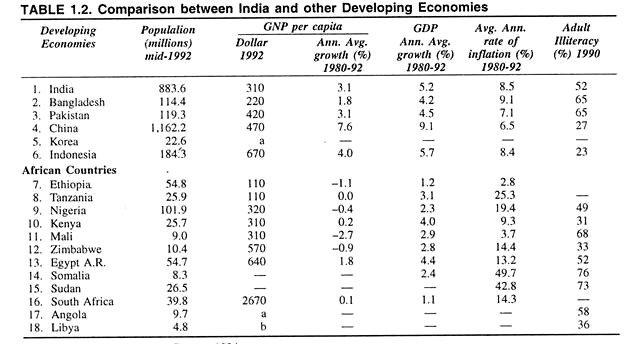Comparison between India and Other Developing Countries!
1. Population:
Table 1.2 reveals a comparative picture regarding some important economic aspects between India and some developing economies. It is found that India and China are the two most populous countries of the world having their size of population to the extent of 883.6 million and I 162.2 million respectively.
Other selected developing countries which are also having considerable size of population include Indonesia (184.3 million), Pakistan (119.3 million), Bangladesh (114.4 million) and Nigeria (101.9 million).
2. Per Capita GNP:
ADVERTISEMENTS:
The per capita GNP in India was $ 310 in 1992 as compared to $ 220 of Bangladesh, $ 420 of Pakistan, $ 470 of China, $ 670 of Korea, $ 320 of Nigeria, $ 310 of Kenya and Mali, $ 570 of Zimbabwe, $ 640 of Egypt A.R., $ 2670 of South Africa and only $ 110 of Ethiopia and Tanzania.
Average annual growth rate of per capita GNP in India was only 3.1 per cent during 1980-92 as compared to 7.6 per cent for China, 4.0 per cent for Indonesia, 3.1 per cent for Pakistan, 1.8 per cent for Egypt and Bangladesh, 0.2 per cent for Kenya, 0.1 per cent for South Africa and negative growth rates in various African countries like Mali (-2.7 per cent), Ethiopia (-1.1 per cent), Nigeria (-0.4 per cent) and Zimbabwe (- 0.9 per cent).
3. Growth Rate in GDP:
The annual average growth rate in GDP of these developing countries also varied widely during the period 1980-92.
The annual average growth rate of GDP in India was 5.2 per cent during 1980-92 as compared to 9.1 per cent for China, 5.7 per cent for Indonesia, 4.5 per cent for Pakistan, 4.2 per cent for Egypt, 3.1 per cent for Tanzania, 2.9 per cent for Mali, 2.8 per cent for Zimbabwe, 2.4 per cent for Somalia, 1.2 per cent for Ethiopia and only 1.1 per cent for South Africa.
4. Rate of Inflation:
ADVERTISEMENTS:
The developing countries have been experiencing high rate of inflation but these rates of inflation experienced by these developing countries also varied widely. During 1980-92, India had experienced an annual average rate of inflation to the extent of 8.5 per cent as against 9.1 per cent of Bangladesh, 8.4 per cent of Indonesia, 7.1 per cent of Pakistan and 6.5 per cent in China.
But the annual average rate of inflation experienced by the African countries during the same period was as high as 49.7 per cent in Somalia, 42.8 per cent in Sudan, 25.3 per cent in Tanzania, 19.8 per cent in Nigeria, 14.4 per cent in Zimbabwe, 14.3 per cent in South Africa, 13.2 per cent in Egypt, 9.3 per cent in Kenya and as low as 3.7 per cent and 2.8 per cent in Mali and Ethiopia respectively.
5. Adult Illiteracy:
In respect of Adult illiteracy the condition of the developing countries is also not at all encouraging. In India, the rate of adult illiteracy in 1990 was 52 per cent as compared to 65 per cent in both Bangladesh and Pakistan, 76 per cent in Somalia, 73 per cent in Sudan, 68 per cent in Mali, 58 per cent in Angola, 52 per cent in Egypt, 49 per cent in Nigeria, 36 per cent in Libya, 33 per cent in Zimbabwe and 31 per cent in Kenya.
But this rate of adult illiteracy has been considerably reduced to 23 per cent in Indonesia and 23 per cent in China.
ADVERTISEMENTS:
Thus, we have seen that inspite of repeated efforts; India could not make much headway in raising its per capita GNP, average annual growth rate of its GDP and per capita GNP also to reduce the extent of adult illiteracy as compared to countries like China, Indonesia, Korea etc. But the condition of India is to some extent better in comparison to that of Bangladesh and some African countries.
